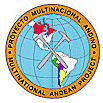| |
Multinational Andean Project Products Update
MAP CD-ROM
The creation of MAP CD continues apace, with an alpha version anticipated for the week of July 4. It will comprise a startup screen, skeletal documentation in HTML format, and an Arc/Info library and Surview (shapefile) implementation for several themes. Themes that will appear on the alpha CD are: bedrock geology, metal deposits, geochemisty, geochronology, paleontology, transportation and drainage. These layers have been compiled for the purpose of testing and will be replaced with final versions once editing is complete.
The alpha version is for review purposes only. Over the next three months more layers will be added, and supporting documentation will be written. All feedback and suggestions for improvement are welcome. Please contact Dr. Andrew Makepeace at [email protected]
Metallogenic Map
" All of the latest deposits and edits have been incorporated into the map for all countries.
" All of the geology edits have been made for all countries, except a few minor questions.
" Additions to northwest Argentina topography are complete.
" The map will probably need to be reformatted to fit on a smaller sheet as it is too big for the offset printer. It will be shrunk down from 65 long to 62.5, and the title of the map at the top of the sheet needs to be moved or dropped.
" Legend containing borders, roads, towns, lakes, etc. has been added.
" Dozens of minor edits were discovered at the meetings in Toronto and have been corrected.
" Frontispiece has been created according to specifications provided by Chile.
" Dr. Eduardo Zappettini and Dr. Moyra Gardeweg will be be visiting Vancouver on the week of June 25th to help with final edits to the map.
Work to be done:
" Arrange printing contract.
" Geology for southeast Peru.
" Geology edits along Peru/Chile border.
" Renumber the deposits from north to south and west to east.
" Generate a series of maps of each bedrock unit for inclusion in the memoirs.
MAP Sample Database Update
MAPdb is fast approaching completion, and is on track for the final version being complete and ready for final testing in July or August 2001. Congratulations and thanks are due to all four participating countries for supplying us with almost all the sample location data that was missing from the previous version of the database and highlighted at the last Executive Council Meeting (Toronto). In the last two months there have been a series of additions resulting from suggestions by the participating countries and colleagues in Canada. These include the replacement of questionable Spanish geological terms by ones agreed upon by the Executive Council, addition of a layout to help users add their own maps to the map viewer and plotter, addition of detection limits fields for all chemical components (major and trace elements), and the addition of a geochronology graphing scheme. The geochronology graph allows users to inspect graphically the growing number of ages in the database and has four different age ranges: the entire geological time scale, the Phanerozoic, the Cenozoic, and the late Quaternary (0 to 100,000 years). Sample ages are plotted against the percentage error in the age, to provide a graphical indication of the data quality. Geochronology plots have the same functionality as the chemical plots in the previous version of MAPdb, allowing users to search the database graphically and highlight (identify) individual samples using a cross-hair. A screen capture of the Cenozoic geochronology plot, with 53 samples plotted, is shown above.
Still to be completed is the addition of a trace element plot and, of course, the input of all remaining data. If prospective users have any questions, comments or suggestions for revisions, contact Dr. Mark Stasiuk at [email protected] as soon as possible.
MAP Samples Update
" No new samples for radiometric dating will be accepted by MAP, due to the long time required for analytical results to be produced.
" Samples from Peru are to be sent to ALS Chemex Laboratories for whole rock major and trace element (including rare earth element) analyses, and thin sections will be made. One batch of 137 samples is ready to go, and a recently received batch of 42 samples may be approved soon for geochemical analysis. However, these samples cannot be dated radiometrically at this time as part of the MAP project.
" Due to the reduced need for a sample coordinator as MAP analytical activity comes to a close, Dr. Jennifer Getsinger will be leaving MAP and the GSC at the end of June, after a busy 2-year contract. Remaining sample data handling and laboratory liaison will be covered by Stasiuk and Ms. Brenda Marie Brannstrom.
" Mr. Mike Villeneuve (GSC Geochronology Lab, Ottawa) has sent to Vancouver final reports on some recently analysed MAP radiometric dating samples, which are being distributed to the countries. For Chile, the report includes 9 U/Pb zircon dates, with one confirmation from a U/Pb titanite date; 1 preliminary U/Pb zircon date; 1 unsuitable (no zircons); and 1 Ar/Ar biotite date. For Argentina, the report includes 1 preliminary U/Pb zircon date, while 7 Ar/Ar dates are still in process. All radiometric dating work is completed for Bolivia, with final results reported for 29 Ar/Ar samples, including some that had previously been put on hold, and later approved for re-analysis.
" The MAP Sample Standards (Geochemical Reference Materials) Project has been successful in producing three new standards for South America: a rhyolite from Peru, andesite from Chile, and basalt from Argentina. Sample bottles are in the process of distribution to the countries. It was originally intended to create a set of five standards, including a dacite from Bolivia and basaltic andesite from Chile; however, unforeseen difficulties have prevented timely collection of suitable sample material in these countries. Countries are encouraged to continue developing custom geochemical reference materials on their own when conditions are more favourable, using the MAP standard set and production process as a model.
|

